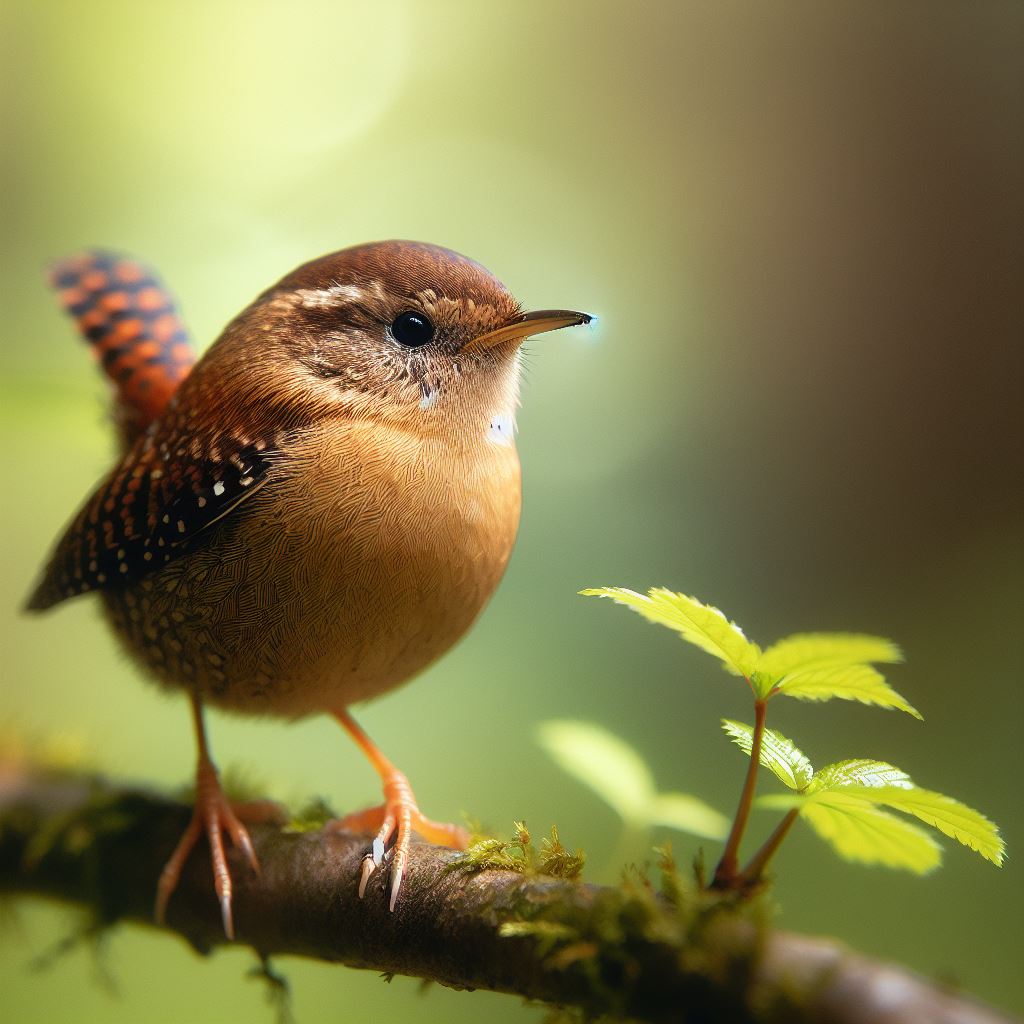Most beautiful small birds - Sykalo Eugen 2024
Eurasian Wren (Troglodytes troglodytes)
Identification:
- Species name: Eurasian Wren
- Scientific name: Troglodytes troglodytes
- Family: Troglodytidae (Wrens)
- Order: Passeriformes (Songbirds)
- Subclass: Neornithes (Modern birds)
- Class: Aves (Birds)
Description:
- Size: Tiny, about 9-10 cm (3.5-3.9 in) long with a wingspan of 13-17 cm (5.1-6.7 in).
- Body shape: Plump and round, with a short neck, a long, cocked tail, and a slender, downcurved beak.
- Plumage color:
Upperparts: Rich rufous-brown, finely barred with darker brown.
Underparts: Dull grey, also finely barred.
Short, dark brown legs.
Small, dark eyes.
- Beak: Long, slender, and downcurved, dark brown in color, perfect for probing into crevices and extracting insects.
- Tail: Short and rounded, often held at a jaunty angle.
Behavior:
- Method of feeding: Insectivorous, gleaning insects and spiders from foliage and crevices.
- Reproduction: Builds domed, moss-lined nests in cavities and crevices. Lays 4-8 pale blue eggs with reddish markings. Both parents care for the young.
- Movement: Resident in most of its range, with some dispersal in response to cold weather.
- Communication: Loud and complex song with rapid trills, warbles, and imitations of other birds. Males sing to defend territory and attract mates.
Ecology:
- Habitat: Woodlands, hedgerows, thickets, gardens, and other areas with dense vegetation and undergrowth.
- Diet: Insects, spiders, and other invertebrates.
- Hunting methods: Forages actively through foliage and crevices, probing with its long beak and flitting with quick bursts of energy.
Distribution: Found across Europe, Asia, and parts of Africa. Introduced to New Zealand.

The Eurasian Wren, that tiny bundle of melody and determination gracing European and Asian landscapes, might seem unassuming at first glance. But beneath its humble brown plumage lies a treasure trove of fascinating facts and adaptations that will leave you mesmerized by this feathered dynamo:
Melody Masters: Don't underestimate the sound that erupts from this tiny bird. Eurasian Wrens are vocal powerhouses, their loud, complex songs filling the air with a melody that belies their size. Think of them as feathered opera singers with built-in high-powered microphones!
Architectural Marvels: Forget grand nests in tall trees; Wrens are champions of the undergrowth. They build intricate, domed nests tucked away in cavities, burrows, or even within man-made structures. Imagine them as feathered architects with built-in miniature construction kits!
Unexpected Polygamy: Unlike many songbirds, Wren males can have multiple breeding females at the same time. They juggle this harem by building several nests and spreading their attention to ensure the success of their offspring. Talk about feathered Don Juans with built-in time management skills!
Hidden Insect Hunters: Despite their small size, Wrens are fearless insectivores. They flit through dense foliage, gleaning hidden bugs and larvae with their sharp beaks, keeping insect populations in check and adding a touch of feathery agility to the undergrowth. Imagine them as feathered ninjas with built-in miniature flyswatters!
Unexpected Winter Warriors: While many songbirds migrate south for the winter, Wrens are resilient year-round residents. Their thick feathers and efficient metabolism allow them to thrive in frigid temperatures, adding a splash of brown to the snow-covered landscapes. Talk about feathered polar bears with built-in winter jackets!
Symbiotic Symphony: Wrens play a vital role in the ecosystem. By controlling insect populations, they help maintain the health of forests and grasslands, contributing to a balanced natural symphony. These feathered pest controllers are gardeners of the undergrowth, ensuring the flourishing of plants and other creatures.
Cultural Charmers: For centuries, the Eurasian Wren has held a special place in European and Asian cultures. It appears in folklore, songs, and even art, often symbolizing hope, resilience, and the simple beauty of nature. It's a testament to the enduring fascination we have with this tiny but captivating bird.
Song Variation Surprise: Did you know? Wren songs vary dramatically across their range! Different dialects and regional accents add to the diversity of their musical repertoire, creating a feathered choir with built-in cultural diversity!